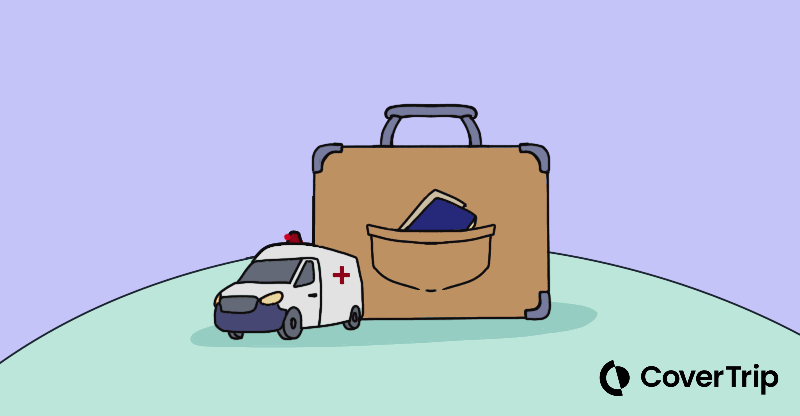How to Manage a Medical Emergency Abroad
6 September 2025
While proper preparation is crucial (including having comprehensive travel insurance with pre-existing medical condition coverage if needed, creating a travel medical portfolio, and packing an appropriate travel medical kit), the difference between a manageable situation and a nightmare often comes down to knowing exactly what to do in those critical first moments.
While proper preparation is crucial (including having comprehensive travel insurance, creating a travel medical portfolio, and packing an appropriate travel medical kit), the difference between a manageable situation and a nightmare often comes down to knowing exactly what to do in those critical first moments.
This article focuses on what to do when a medical emergency happens – when there’s no time to research your options. From the first 10 minutes of crisis through making critical treatment decisions under pressure, you’ll have a clear roadmap for managing any medical emergency while traveling internationally.

What to do in the first 10 minutes
When a medical emergency strikes abroad, your pre-travel preparation becomes your lifeline. If you followed the advice in our guide to finding medical care abroad, you already have your travel insurance assistance number programmed in your phone, you know the local equivalent of 911, and you have your medical portfolio ready.
Now it’s time to put that preparation to work!
Step-by-Step Response for Different Types of Medical Emergencies:
- For life-threatening emergencies: Call local emergency services first – don’t waste time with insurance when someone’s life is at stake. Have someone else call the travel insurance assistance line while emergency responders are en route, and gather the patient’s medical documents and medicines for the hospital.
- For non life-threatening situations: Start with your travel insurance assistance line. They’ll direct you to the most appropriate facility, coordinate coverage, and often provide translation services. This saves time and ensures you’re going to a facility that accepts your coverage.
- For moderate medical issues: Your insurance assistance line can recommend English-speaking providers and verify coverage before you incur expenses. Document the incident with photos and detailed notes for your claim.
If you’re traveling alone, prioritize your safety first:
- For life-threatening emergencies, focus entirely on getting help – call local emergency services and don’t worry about insurance until you’re stable.
- For non-life-threatening situations, call your travel insurance first, then ask them to stay on the line while you or they arrange transport to the recommended facility.
Many insurance providers can make three-way calls to medical facilities to coordinate your arrival and coverage.
How to Communicate with Local Emergency Services and Medical Staff
Language barriers don’t have to be life-threatening. Use simple words for the emergency (“heart,” “breathing,” “bleeding”), show medication bottles to communicate current treatments, and point to affected body parts when words fail. Your travel insurance provider may have translation services available during your call, and many can conference in with local medical staff to help bridge communication gaps.
Pro tip: Use a translator app on your phone to communicate in real-time with first responders.
When and How to Contact Family Back Home
For serious emergencies requiring hospitalization, contact the patient’s family as soon as you have basic information about the patient’s condition and treatment plan.
Before contacting family members, consider waiting until you have a precise diagnosis and treatment plan for minor emergencies.
If you’re traveling alone:
- Your pre-trip preparation should have included adding an In Case of Emergency contact to your phone and in your wallet. If you’re incapacitated abroad, the medical staff can contact your family for you.
- Wait to get in touch with your family until after you have a diagnosis and treatment plan.
Most travel insurance plans with travel medical coverage include the option to bring a family member to your side if you are hospitalized for a certain number of days.
What to do at the hospital or treatment facility
Various regions of the world have different approaches to medical treatment that may look quite different than what you’re used to. Add in a cultural or language barrier, and it can feel quite scary. Just because it looks different doesn’t mean it’s not as good – that’s important to remember.
- If English is your first language, ask for an English-speaking doctor, nurse, or translator. Many hospitals in tourist destinations have them, and if not, your travel insurance provider can arrange for telephone translation services.
- Be aware that in some countries, doctors may discuss your condition with family members present or expect family to be involved in treatment decisions, even if you prefer privacy. If you want to speak with medical staff alone, clearly state this preference.
- Before you leave any medical facility, get detailed receipts with specific procedure codes, medication names, and physician credentials. Many countries don’t provide the itemized billing that US insurance companies expect, so ask specifically for charge breakdowns.
- Take photos of all documents, prescriptions, and medical equipment – getting records from abroad later is nearly impossible, and your insurance company needs this evidence to process claims.
The key is to stay flexible with different medical approaches while being firm about obtaining the documentation you need for insurance purposes.
After the Emergency: Getting Home Safely
Once the immediate medical crisis is stabilized, you’ll face important decisions about continuing the necessary care abroad or returning home. These choices can significantly impact your recovery and your finances, so it’s crucial to make them carefully and with the right information.
Medical evacuation vs. continuing treatment abroad
Your travel insurance provider and local medical team will determine if medical evacuation is necessary or if you should wait and continue treatment locally. Evacuation isn’t automatic – it’s typically only covered when local facilities can’t provide adequate care for your condition. If local treatment is medically appropriate, your insurance may require you to stay and recover abroad rather than pay for an expensive evacuation.
Coordinating follow-up care and medication needs
Before leaving any foreign medical facility, get copies of all test results, treatment records, and discharge instructions – if possible, translated into English. Ask for generic medication names in addition to brand names, as your prescriptions may go by different names at home. Your travel insurance can often coordinate with your home doctors to ensure continuity of care.
Protecting yourself from surprise medical bills
Keep every receipt, even for items that seem minor, like bandages or translation services. Contact your travel insurance provider before agreeing to expensive procedures or extended hospital stays – pre-authorization can save you thousands of denied claims. If you’re asked to pay upfront, get detailed receipts but ask the facility to bill your insurance directly when possible. Often, if you get the insurance provider on the phone, they can coordinate that for you.
Pro tip: Contact your embassy when you have legal issues related to your medical care, need help replacing documents while hospitalized, or your insurance company can’t resolve payment disputes with local providers.
The goal is to get home safely while protecting your financial well-being—don’t rush decisions that could affect your health and your wallet.
Damian Tysdal is the founder of CoverTrip, and is a licensed agent for travel insurance (MA 1883287). He believes travel insurance should be easier to understand, and started the first travel insurance blog in 2006.
